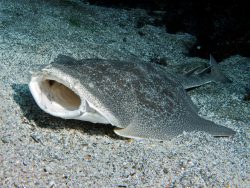select your film:


The Japanese Angel shark is found in the northwestern Pacific Ocean off China, Japan, and Korea. It is a close relation to both the Taiwanese and Indonesian Angelshark, but diverged into its own distinct species during the Cretaceous period, around 100 million years ago. Females reach maturity at 80cm but can grow up to 150cm long, whereas the size at which males mature is unknown. They give birth to live young, in litters of between 2 and 10 pups.
Like other Angelsharks, they have flattened bodies and broad pectoral and pelvic fins which make them similar in appearance to rays. They have 10 rows of teeth on both their upper and lower jaws, which are small and pointed. These sharks are ambush predators, which means they hide, motionless, on the ocean floor and wait to strike when prey comes within range. They survive on a diet of fish, crustaceans and cephalopods like squid.
Japanese Angelsharks have traditionally been fished for their meat but also for their skin, which can be made into a kind of leather called Shagreen. The rough surface of the shagreen has been used for polishing wood but also for covering the hilt of a sword for good grip. In the 18th century, it was highly popular in Europe as it is easily dyed.
Do you have images or videos of Japanese Angelsharks?
Submit them to [email protected].
